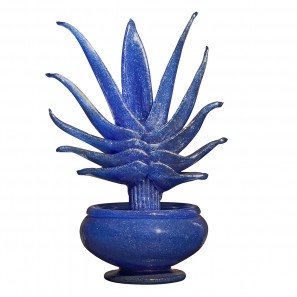
Napoleone Martinuzzi. Venini 1925–1931

Venice, Island of San Giorgio Maggiore
EXTENDED UNTIL JANUARY 6, 2014
The exhibition Napoleone Martinuzzi. Venini 1925-1931, curated by Marino Barovier, will open to the public on the island of San Giorgio Maggiore in Venice on September 8th, 2013. It is the second exhibition dedicated to the history of the Venini glassware company promoted by Le Stanze del Vetro, a long-term cultural initiative launched by Fondazione Giorgio Cini and Pentagram Stiftung, devoted to the study and the promotion of the art of glassmaking in the twentieth century. Le Stanze del Vetro envisages, among its many cultural activities, ten exhibitions, taking place on a yearly basis, focussing on Venini, whose production represents a landmark in 20th-century artistic glass manufacturing. Each monographic exhibition will present the work of one of the artists who over the years collaborated with the glassware company from Murano. Each exhibition will be accompanied by a catalogue that will form, at the end of the long-term program, the catalogue raisonné of the Venini production.
The exhibition space for Le Stanze del Vetro was designed last year by Annabelle Selldorf Architects of New York. Annabelle Selldorf Architects specialize in the design of exhibition spaces and museums, and have decided to collaborate with some of the most important Venetian craftsmen, namely Augusto Capovilla and Gino Zanon, two family-run companies that represent local excellence in various fields. As in the case of the exhibition Carlo Scarpa. Venini 1932-1947 – which opened on the Island of San Giorgio last August and will open at the Metropolitan Museum of Contemporary Art in New York next November (November 5, 2013-March 2, 2014) – this exhibition, dedicated to Napoleone Martinuzzi, is made possible thanks to thorough research by Marino Barovier and a group of scholars on the history of the Murano glass-making company and on the important designers who contributed to making it renowned throughout the world. Through the analysis and cross-checking of various documentary sources (photos, catalogues, furnace drawings) and their comparison with the real objects provided by museums, public and private institutions, Italian and foreign collectors, a comprehensive review was made of the glass objects designed by Napoleone Martinuzzi between 1925 and 1931, when he was the Art Director of Venini.
During the period of his collaboration with Paolo Venini, Martinuzzi designed beautiful objects whose shapes are inspired by classical design, but through the use of innovative techniques and of glass paste. The exhibition Napoleone Martinuzzi. Venini 1925 – 1931 traces his whole production chronologically: from the elegant transparent blown glass to the works with an unprecedented opaque texture, from the experimentations with pulegoso glass (a semi-opaque or translucent glass with a rough surface due to tiny bubbles that form by using special ingredients) to pieces with intense and compact colours.
There are about 200 works on display, covering the most significant glass production of the ingenious sculptor from Murano. Many of these works were presented at the Venice Biennale between 1926 and 1930, and at the great exhibitions of decorative arts, in particular the Biennale and the Triennale in Monza. 1930 was an important year in the history of Venini: thanks to Martinuzzi’s talent, the Venini production was noted for the singular richness of the works shown at these great exhibitions. The classical transparent glass pieces were presented, along with a collection of pulegoso glass with an archaic flavour, the striking aquariums together with the brightly coloured velato vases, the cacti together with a colourful bestiary.
The exhibition also delves into the bond between Martinuzzi and the poet Gabriele D’Annunzio, who commissioned the Murano artist to make not only sculptures but works of glass too. To illustrate this particular bond and the artistic vision shared by these two personalities, the exhibition also contains a recreation by the set designer Pierluigi Pizzi of one of the rooms of the Vittoriale, with some of the most important works that Martinuzzi designed for the poet: the bright pumpkin made of “incamiciato” glass (where the glass is covered by a second thin layer of different colour glass) which Martinuzzi designed upon specific request by the poet for his residence, the vase with large ribbed handles, the large basket with fruit, the transparent blue glass cup and the elephant made of red vitreous paste. Each of these objects is a unique piece.
The exhibition Napoleone Martinuzzi. 1925 – 1931 Venini will open on September 8th, 2013 and will run until December 1st, 2013 from 10 am to 7 pm (every day except Wednesdays). Admission is free.
The free educational programs for students from primary to secondary school will also continue running during this exhibition, along with the free guided tours for the visitors of “Le Stanze del Vetro”. More specifically, the educational programs will include activities and workshops, during which teenagers and children will discover the history and the importance of the art of glassmaking in Venice, producing artifacts and participating in laboratory activities and discussions.
In order to take part in the educational program it is necessary to book in advance by calling the toll-free number 800662477 (Monday to Friday from 10 am to 5 pm) or by sending an email to:artsystem@artsystem.it.
For detailed information on the many activities for different age groups: www.artsystem.it
